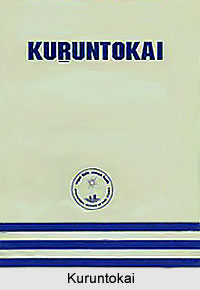 Kuruntokai, also known as Kurunthogai, is a classical poetic work in Tamil and constitutes as the second book of the Ettuttokai or Ettuthokkai anthology in Tamil literature from the Sangam age. Kuruntokai consists of numerous verses that deal with themes and subject matter of love, emotions and severance. The verses in the poetic were composed by several poets and authors. A Tamil scholar named Nachinarkiniyar, who lived during the 6th or the 7th century CE has written annotation on the work of Kuruntokai (Kurunthogai).
Kuruntokai, also known as Kurunthogai, is a classical poetic work in Tamil and constitutes as the second book of the Ettuttokai or Ettuthokkai anthology in Tamil literature from the Sangam age. Kuruntokai consists of numerous verses that deal with themes and subject matter of love, emotions and severance. The verses in the poetic were composed by several poets and authors. A Tamil scholar named Nachinarkiniyar, who lived during the 6th or the 7th century CE has written annotation on the work of Kuruntokai (Kurunthogai).
Content of Kuruntokai
The poetic work of Kuruntokai comprises of a renowned poem titled the Red Earth and Pouring Rain, written by the poet Sembula Peyaneerar who composed many verses of Tamil literature from the Sangam age. Red Earth and Pouring Rain is constituted in the 40th verse in the Kuruntokai collection. The picture that is illustrated in the poem red earth and pouring rain portrays the image of the arrival of the first monsoonal rains in the Tamil land. The rains fall on the earth, which are naturally coloured red, in the hilly areas of the Tamil country, and are a typical feature of the region. The drops of rain merge with the dried out and scorched soil and form cool damp clay. Eventually the flowers begin to bloom with the advent of the rain.
Through the vivid narration of the natural surroundings, the poem Red Earth and Pouring Rain in the Kuruntokai anthology creates a setting and mood where two separated lovers covertly and stealthily meet with each other in the monsoon soaked hills. The lovelorn protagonist and his lover are pleased to see one another after a long time and their hearts, unexpectedly and suddenly, begin to beat rapidly as a result of being together. The poem also conveys a second level of implication and meaning which is which the poet creates through his words by illustrating an image of sequence and progression.
The poem Red Earth and Pouring Rain commences with the probable bonds of camaraderie and friendship, and then the development of affiliation, understanding and relationship between the parents. The verse then shifts to describe about the relationship formed by two people who are learning, discovering new things and are getting to know each other. These concepts and ideas create a concrete imagery of the inherent picture of red earth in the rain, which narrates the quest and journey of two lovers from loneliness to unification, in a parallel line.
Lastly, there is also the image of the Kurinji flower, which even though is not mentioned in the poem Red Earth and Pouring Rain in the Kuruntokai collection, but is present as an essential part of the hilly landscape in the Tamil land. The Kurinji flower blossoms only once in 12 years, which is also the period related with Tamil tradition when a girl matures and reaches womanhood. The poem depicts, through the image of the flower, the sense of a woman maturing to union and awakening to herself.



















